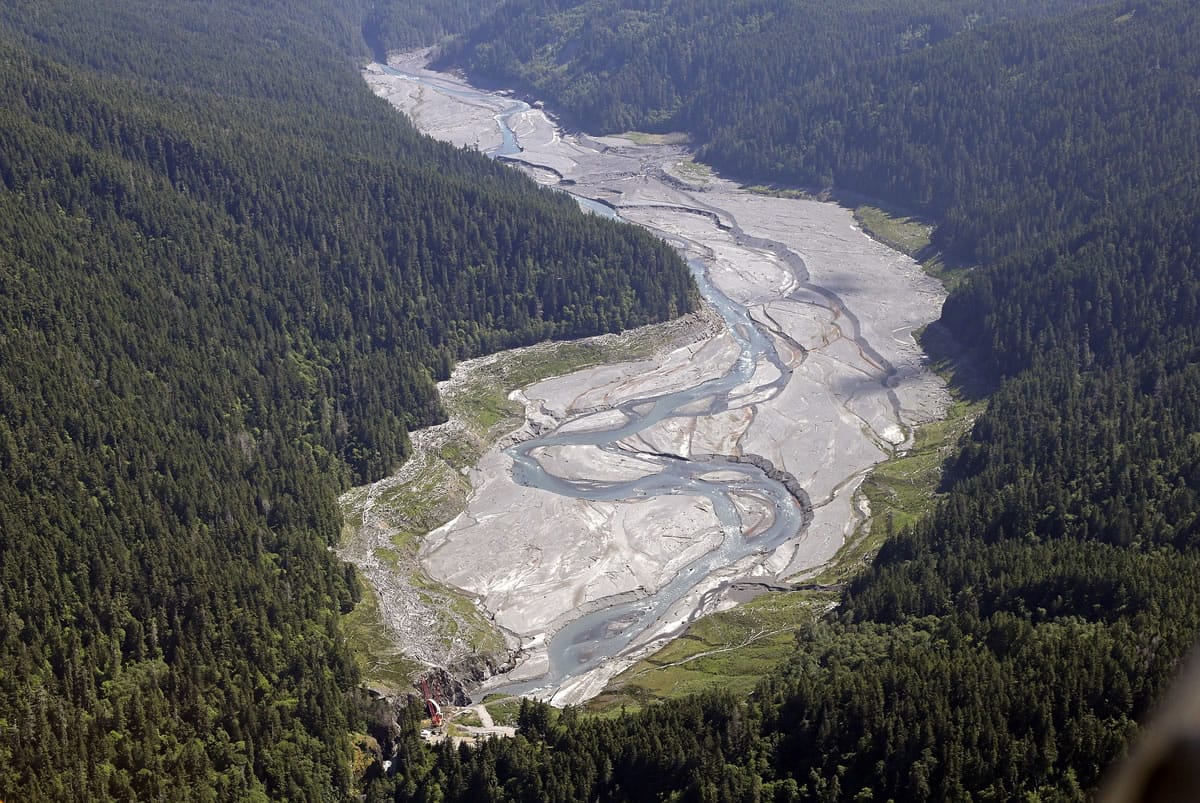PORT ANGELES — The final chunks of concrete are expected to fall this September in the nation’s largest dam-removal project, but nature is already reclaiming the Elwha River on Washington’s Olympic Peninsula.
So much sediment, once trapped in reservoirs behind two hydroelectric dams, has flowed downstream that it has dramatically reshaped the river’s mouth, replenished eroding beaches and created new habitat for marine creatures not observed there in years.
Meanwhile, Chinook salmon and steelhead have been streaming into stretches of the Elwha River and its tributaries previously blocked by the Elwha Dam, which stood for nearly a century before it came down in 2012.
With the first dam gone, the ocean-migrating fish have been swimming as far upriver as they can. Scientists have observed them at the base of the second 210-foot-tall Glines Canyon Dam about 13 miles upstream, as if they want to continue on.
As they move into areas previously blocked, salmon and steelhead are acting as a fertilizer for the ecosystem, delivering marine nutrients to river otters and other wildlife.
Demolition crews this month are waiting for river flows to drop, so they can begin removing the remaining 30 feet of the Glines Canyon Dam. By the end of the year, the Elwha River is expected to flow dam-free from the Olympic Mountains to the Strait of Juan de Fuca, about 80 miles west of Seattle.
Just three years into dam removal, scientists say they’ve been surprised at how quickly changes are happening.
The most stunning change is taking place at the river’s mouth. Millions of cubic yards of sediment held behind the dams have flowed downriver and pushed the estuary out about a quarter mile. A once rocky, cobblestone scene is now sandy beach — ideal for forage fish, juvenile salmon and shellfish.
“New estuary is literally being created. It’s wild to watch,” said Anne Shaffer, marine biologist with the Coastal Watershed Institute in Port Angeles. “Fish are using this freshly formed habitat, and they’re using it with such abundance.”
Marine creatures such as eulachon, or candlefish, and Dungeness crab have been documented in the estuary for the first time in decades.
“I was surprised by a lot of things, but I was stunned by how fast the estuary has expanded,” said Robert Elofson, river restoration director with the Lower Elwha Klallam Tribe. The tribe is a partner with the National Park Service in the $325 million river-restoration project.
An estimated 40 to 50 percent of the total expected sediment has come down the river so far, said Andy Ritchie, project hydrologist with the National Park Service. Not all of what remains will make its way down, he said. Some won’t be released except during very high river flows, and some is beyond the river’s reach, Ritchie added.
All that sediment has created turbid and muddy waters for migrating fish, and scientists initially wondered how salmon and steelhead would react.
But tribal and federal biologists tracking fish have been able to answer intriguing questions, including: When the dams are removed, will the fish survive in turbid waters?
“Those fish are finding the clear creeks, and they’re spawning,” said John McMillan, a biologist with the National Oceanic and Atmospheric Administration. “The clear water sources are really important.”
Once they get into the river, “their instinct is just to go upstream. They’ll go as far as they can to see what’s there,” he said.
On a recent day, McMillan pointed out an adult steelhead as it swam from the murky, grey waters of the Elwha river into clear Indian Creek, one of two tributaries open to the fish now that the Elwha Dam is gone.
In recent weeks, McMillan and another tribal biologist have been counting steelhead fish nests in Indian Creek and Little River. So far they’ve counted 108 redds in those tributaries, as well as a couple in the main river.



